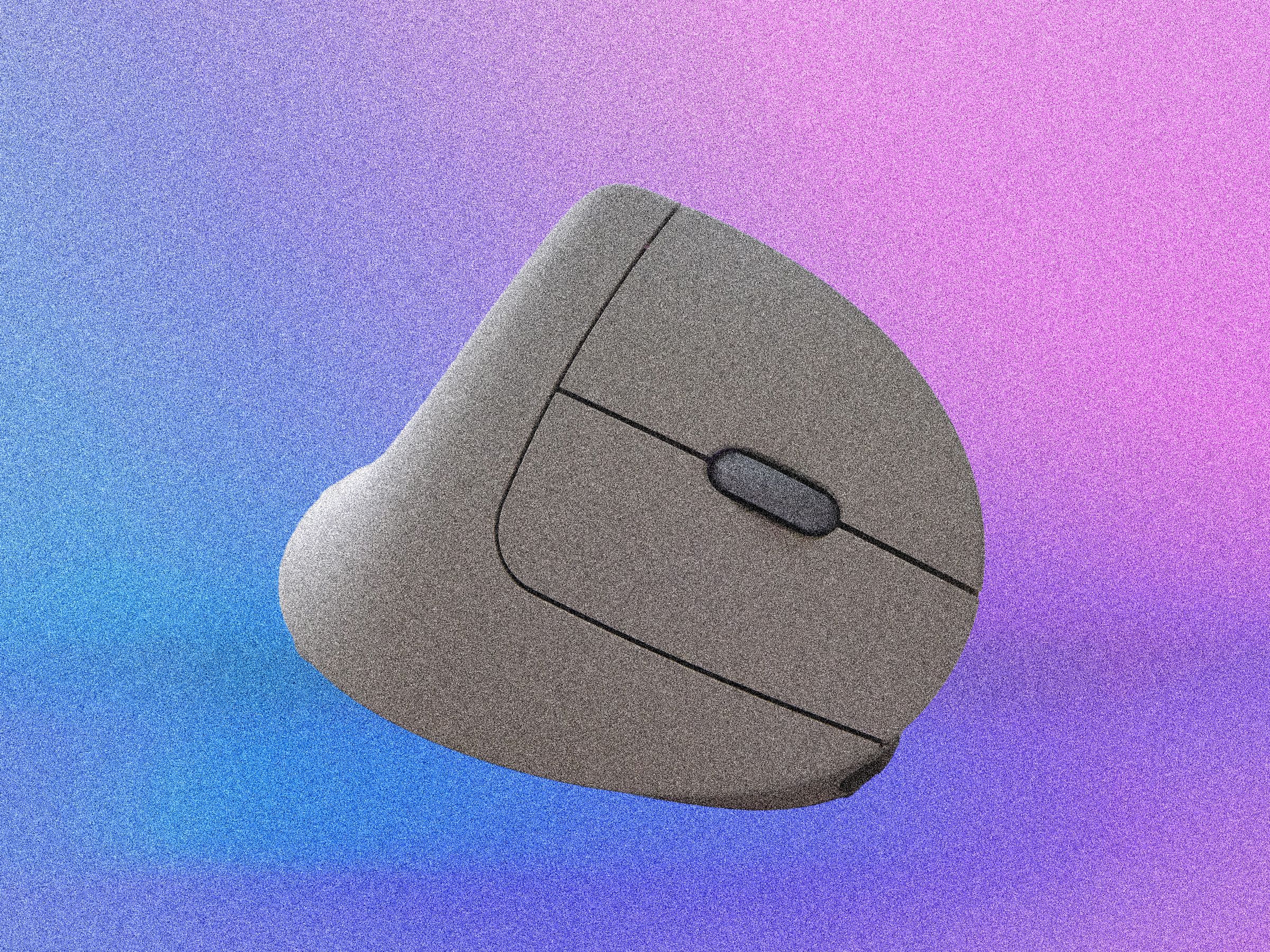I’ve never been a vertical mouse person. These mice have a vertical shape that puts your palm in a more neutral posture, reducing strain on the wrist. But every time I’ve used one in the past, it felt awkward, unnatural, or like I was making a trade-off in exchange for better ergonomics. They just never worked for me—until the Hansker Productivity Mouse came across my desk.
It takes the standard vertical mouse formula, but sculpts the angles and curves for an incredibly natural feel. All that while still offering everything you’d want in a modern mouse, from speedy wireless connectivity, USB-C recharging, left- and right-clickers, a scroll wheel, two programmable thumb buttons, and multi-device connectivity via Bluetooth.
Hansker’s mouse comes in two flavors: Productivity and Performance. Both have a high 1,000-Hz polling rate, which is how fast the mouse sends its data to the PC. The Performance costs $140, weighs 90 grams, uses a higher-performance sensor, and is available in black. The Productivity costs $115, weighs 116 grams, uses a slower sensor, and comes in a warm off-white.
Informed Design
Photograph: Henri Robbins
Hansker’s founder, Alex Muñoz, tells me a lot of research went into the shape of the Productivity Mouse. Its design is heavily influenced by research on ergonomics published in the National Library of Medicine, which guided the ideal angle and shape for a vertical mouse to reduce wrist strain. Then Muñoz went through multiple prototypes to find a one-size-fits-all shape that worked for various hand sizes.
“The way we went about this was to find a shape, a form factor, and a size that fits as many people as possible with the knowledge that one size doesn’t fit all,” Muñoz says. “I realized that bigger forms are usually more comfortable for most people.” In my testing, I found this accurate as well. I had several people test this mouse, each with varying hand sizes, and nearly all of them said the Hankser Productivity was comfortable to hold and use, regardless of hand size.
Photograph: Henri Robbins
Another emphasis was a desire to create a vertical mouse that didn’t look terrible. The Hansker is one of the only ones I’ve used that doesn’t become an eyesore on any desk it inhabits. The mouse’s smooth curvature and well-placed lines make it look like it was sculpted from clay. The design is clean, without being so simple that it sacrifices functionality for form.
My hand slips perfectly onto this mouse, and every button is within reach from a resting position. The thumb buttons are elongated, making them easy to reach by smaller and larger hands, and all four of the buttons use the same microswitch underneath to create a consistent feel and sound. The small bevel at the bottom of the mouse creates a ridge that my fingers can easily use to pick up and move the mouse, something that’s absent on most vertical mice. The shape feels intuitive.
Photograph: Henri Robbins
The most impressive part is the resting position of your hand. Many of the vertical mice I’ve used in the past have had harsh curves on the exterior that meant the palm of your hand had nowhere to rest. Instead, you would have to let your hand hover next to the mouse or rest the bottom of your hand on the desk while holding it, with only a ridge inside for your thumb to sit on. The outside angle of the Hansker Productivity is shaped perfectly to let your palm rest on the mouse. Because of this, the natural position feels comfortable and relaxed, and lets you easily glide the mouse across your desk without angling your hand unintuitively or hovering.
While I love the color of the Productivity model (which pairs perfectly with retro-styled beige keycaps), it likely won’t be for everyone. The off-white color has trouble blending in with an all-white computer workstation, and is much warmer than the typical cool white of most peripherals. The black on the pricier Performance model, like always, works with everything.
Performance-Focused Wireless
Photograph: Henri Robbins
The Productivity Mouse, shockingly enough, performs incredibly well with everything I threw at it. The Pixart 3325 sensor is leagues ahead of the average nongaming mouse, and the 1,000-Hz wireless connectivity is fast. This sensor isn’t top-of-the-line, but it’s competent for a hybrid gaming/work mouse. I didn’t experience any input lag or issues with responsiveness, and the sensor was capable of both high-precision work and high-speed movements.
The Hansker also has multi-device connectivity, which is nearly mandatory for productivity devices today. This is done via Bluetooth, which means connectivity is limited to 125 Hz, like any other Bluetooth device, though that’s still fine for most uses. The device swapping is odd, requiring you to press the left, right, and middle mouse buttons to swap between devices instead of a typical Bluetooth button on the underside.
Photograph: Henri Robbins
The Hansker Controller software, while functional and incredibly lightweight, is unrefined in its current state. It’s still in beta and is missing some quality-of-life features like window size adjustment, but it still has all the necessary customizations for adjusting DPI (dots per inch), polling rate, and button mapping. For Mac users, the mouse is compatible with the open source LinearMouse customization software.
The weight of this mouse strikes a great balance between utility and speed. While most gaming mice today strive for lightness at all costs, and productivity mice almost completely ignore weight savings, the Hansker finds a balance. Between the Productivity and Performance models, there is one lightweight mold for the housing. Hansker puts weights on the bottom of the Productivity model to make it feel more substantial, and leaves the Performance mouse empty.
I haven’t always been favorable toward peripherals that add weights, but there’s a time and a place, and this is it. The mouse is already sturdy and stable without these weights, and they only make the mouse feel more planted. Neither compares to the sub-60-gram ultra-lightweight gaming mice you can find today, with the Performance model clocking in at 90 grams and the Productivity model sitting at 116 grams total. My only complaint is that these weights aren’t easily removable, which could have allowed for a bit more customization by the user. This isn’t common, but I had a SteelSeries Rival 600 with this feature years ago.
Lightweight With Longevity
Photograph: Henri Robbins
On the outside, the Hansker Productivity is as simple as a mouse can get. It has two standard buttons, two programmable thumb buttons, and a basic scroll wheel. The exterior is made from ABS plastic without soft-touch coatings or other surface treatments.
High-end mice from brands like Logitech have soft-touch coatings applied that, while great at first, run the risk of wearing away and leaving either smooth spots or tacky finishes. They also have complex mouse wheel and button designs that, while incredibly sophisticated, have a higher chance of failure. While these features can be fantastic, it’s also great to see a mouse that opts for longevity and thoughtfully simple design.
Opening up the mouse, my only real complaint is the placement of the screws. You need to remove the adhesive feet on the underside to access them. Once removed, the internal assembly is incredibly simple. The shell consists of three pieces that can be taken apart with only a screwdriver, and the internal components—three printed circuit boards with five buttons, a mouse wheel, and a battery—all appear to be off-the-shelf components manufactured by Huano, which will make sourcing and replacing components easy.
Disassembly and reassembly can be difficult due to the extensive use of plastic clips to hold the components together. Getting the two upper parts of the housing together without any light leaking from the top LED took multiple attempts and a bit more force than I’d have liked.
Despite these minor issues, this is the best vertical mouse I’ve used. It doesn’t have the outstanding build quality or complexity of a vertical mouse from a brand like Logitech, but it is simple, solid, and perfectly shaped. It doesn’t feel like corners were cut, and I don’t feel like I’m sacrificing something by choosing an ergonomic vertical mouse. I can honestly see myself buying a Hansker Productivity for personal use—it just feels comfortable and intuitive.



